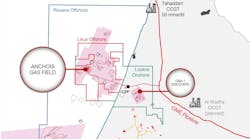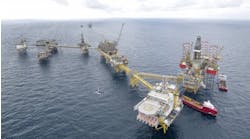Dev George
Houston
A state-of-the-art semisubmersible form Sonat Offshore.
Rig newbuilds almost nigh
Available drilling rigs are becoming more and more difficult to find. In many active parts of the globe, they simply don't exist, they're fully booked for a year or longer. All told, there are only about 50 available rigs crewed and ready for work around the world, out of some 90 idle units - down from 120 last year.
Yet the demand continues to hover at around 450 mobile offshore rigs, as it has for well over a decade. And that demand is often being met by ever-older, less technologically advanced units. In some areas, by decrepit, if not dangerously derelict drillers.
As a consequence of the difficulty in meeting demand, many old and cold-stacked mobile units are being refurbished, sometimes fully rebuilt, and thrust back into the market. [See article on page 33 of this issue.] Others are being converted into production platforms.
The problem is, despite new technology and the resulting improving revenues, day rates are still too low today to justify newbuilds, but will likely rise sufficiently to spark construction of a new generation of offshore mobile drilling rigs within three years, according to Global Marine's chairman, C. Russell Luigs.
"Steerable drilling and 3D seismic have led the technology that is driving up operators' revenues," Luigs said. "That's because they reduce the number of dry holes, sometimes from one in ten to one in five. That, among other things enables you to look at small reservoirs. Your threshold economics are twice as good."
A second factor, according to Luigs, is the rising gas demand in the US and rising oil and gas demand in numerous other regions of the world.
"We're going to have to have enough rigs running to maintain production in order to supply the demand. We're going to go from a day when gas prices determined the number of rigs to a day when gas prices will be whatever they have to be to keep the rigs running. A major switch is about to occur."
Operators appear to have caught on. Salomon Brothers' study of planned worldwide E&P expenditures for 1996 indicated this year will see the greatest increase in planned spending for exploration and production in over five years - up from last year by 7.7%.
Gulf of Mexico day rates, for example, are now between $25,000 and $35,000 for an average, 300-ft jackup - an increase of 13.6% to 20.6% over the course of 1995, but they'll have to go to almost $61,000 to make building a new, average, $75 million jackup. North Sea day rates for a state-of-the-art semisubmersible are between $75,000 and $120,000 - an increase of 66.7% to 84.6% over last year, but they'll have to rise to $116,000 to $191,000 to make building a $130 million large deepwater semi. Luigs says its only a matter of about three years.
Oman to India pipeline stillborn
The thought of constructing parallel pipelines across the Indian Ocean chasms from Oman to India titillates the imagination and evokes visions of Jules Verne adventures. Yet, a $70 million feasibility study conducted by Houston-based Transworld Oil USA (an affiliate of Oman Oil Co.) has determined that the fantastic project is actually viable.
Too late. The $4 billion project, which proposed laying two 24-inch in diameter, 1,150 km long gas pipelines across the ocean floor to carry 50 MMcm/d of gas from Oman to India, is dead in the water. From the start, it was on-again, off-again for one reason or another, but ultimately it came down to Oman's ability to supply sufficient gas to make the project a go, and a lack of financing because of that uncertainty.
Skeptics said all along that the pipeline would never be built, considering the enormous subsea valleys and vast depths the pipelines would have to traverse, that the technology simply wasn't there. But the romantics in the industry defended the idea, holding that robotics and the latest subsea technology could handle it. Rumors, however, have been rampant of the pending demise of the project for more than six months, and thus, when word slipped out that Oman Oil Co.'s new management terminated the project's engineering and risk management contracts earlier this year, it became clear the project was on its last leg.
For quite some time, numerous Indian delegations in London and Houston have been saying off the record that Oman didn't have enough proven gas reserves to make the project feasible. A firm assurance of supply was simply not possible, making the raising of $1 billion in equity from international sources far too difficult for primary investment banker Morgan Stanley, which withdrew from the project a month ago.
Now all survey work has also been stopped, effectively abandoning the Oman to India pipeline project. Even though an official statement to that effect has not yet been issued, the remarkable subsea adventure is now just a fading dream.
Alaskan oil for Asia
Finally, the first shipment of Alaskan North Slope oil bound for Asia is scheduled for sailaway this summer. It's been a long time coming, but US President Clinton's repeal of the 22-year ban on Alaskan North Slope exports last November was a smart move in opening the way for increased exploration and development of the Alaskan arctic. The new law permitting the sales requires shipments to be on US-flagged and US-crewed ships, and it will provide added Alaska income. More importantly, however, it could very well be the foot in the door that may lead to increased oil and gas exports to the rapidly industrializing countries of Asia, which may act as a stimulus to arctic production.
Ironically, it will be British Petroleum that will be sending the first Alaskan oil cargo west, some 10,000 b/d destined for Taiwan. Chinese Petroleum Corp. will be buying about 15,000 b/d of the approximately 100,000 b/d of excess oil that had been shipped to the US West Coast. Japan and several other Asian markets are expected to contract for the remainder.
BRIEFS. . .
Americas:
A 200-mile Gulf of Mexico deepwater oil pipeline is being built by Texaco and Leviathan in a joint venture called Poseidon Oil Pipeline. The US$60 million first phase, a 117-mile segment from Garden Banks Block 72 to shore at Caillou Island, Louisiana, began operating in March. The second phase will connect to Texaco's Fuji Field to serve as a deepwater hub.
Mexico's Pemex has scheduled three of the ten major fields in the Mexican Gulf's Tabasco Littoral region for development - Sinan, Bolontiku, and Hayabil. The fields lie in relatively shallow waters off the coast of Tabasco state southwest of Campeche Sound.
Newfoundland's much ballyhooed Port-au-Port prospect is to be drilled this spring in a one-well commitment by Hunt Oil an Pan Canadian Petroleum. The JV is thought to have a major find just six km southwest of Cape St. George.
Trinidad has been the site of Amoco's highly successful proprietary program of 3D seismic-assisted exploration. In its drilling phase, two of an eight-structure drilling program have been drilled, both successful. In the first, a 3 tcf gas reservoir was discovered; in the second, the El Diablo-1 well flowed 27.2 million cf/d from six zones.
Africa:
Guinea has awarded its entire 16.8 million acres of aquatory to the Houston-based independent, USOil Corporation. The concession is for exploration, development, and exploitation of the hydrocarbon resources of the area, and includes rights to previously acquired seismic, gravity, and magnetic data.
Namibia's Kudo Field is set to see its first well this month. Operator and 75% owner Shell plans production of at least 250 million cf/d beginning about year 2000, with intended market being power generation in South Africa. Engen, the South African refining and exploration company holds 25%.
Nigeria's deepwater Benga Field, now in development by Royal Dutch Shell, is believed to be a very large discovery. The company is currently testing the field, and will not comment on its size, since a major discovery could trigger renewed protests of Shell's involvement with the Nigerian dictatorship.
Angola's Nemba Field, operated by Chevron, has gone on production at 17,000 b/d oil three years ahead of schedule by employing subsea production and an FPSO. The system will remain on site two years, until two permanent structures are in place. The field lies in Cabinda Block B.
Mideast:
Qatar oil discovery made by Gulfstream Resources Canada was in a non-producing gas concession. The discovery well, QMB-4, drilled in the Arab B structure, tested 9,655 b/d oil. Estimated reserves are 1.3 billion bbl. Arco is the concession operator.
Azerbaijan's Socar state oil company and Russia's Lukoil have signed to jointly develop the Azeri Caspian oil and gas giant Shaikh Deniz Field. Lukoil will be operator of the yet-to-be-constituted consortium which will likely include BP, Statoil, TPAO, and perhaps NIOC (National Iranian Oil Corp.).
The Azerbaijan International Operating Company (AIOC), Azerbaijan's Socar state oil Company, and Transneft, Russia's pipeline operator, have finally signed the early oil export agreement by which the AIOC will begin exporting Caspian oil next year. Some 80,000 b/d will transit the Russian pipeline to market. Upon full production, however, some 700,000 b/d will require another, greater capacity system.
Asia:
Bangladesh has another big gas find. Cairn Energy has discovered a major gas reservoir at its Sangu-1 well, which flowed 50 million cf/d in tests. A second test well will be drilled this month to determine the extent of the field.
Yet another Australian gas giant is lining up to support yet another LNG project, as Australia positions itself to enter the 21st Century as one of the world's leading gas marketers. This time its the Phillips-Oryx Bayu Field, with estimates of 3.5-4 tcf gas and about 200 million bbl condensates, located in Block ZOCA 91-13 of the Zone of Cooperation.
New Zealand has awarded seven new blocks - two in Canterbury and five in Taranaki Basins. An additional 14 blocks are now available.
Petro-Vietnam's President Ho Si Thoang has announced that all open blocks offshore Vietnam are available for exploration and development lease, with particularly good terms for deepwater blocks 133, 134, and 135 and other difficult areas.
China's Liuhua Field, located on Block 29-04 in the South China Sea south of Hong Kong, came onstream last month with initial production of 35,000 b/d oil. Full production, by the end of the year, will reach 65,000 b/d. Amoco is the operator, with 49% ownership. CNOOC holds the remaining interest.
Europe:
Wales's Liverpool Bay Block 110-18 will be the site of Chevron's first well in a series of four in 16th Round licenses. Seismic is underway in other blocks in nearby Cardigan Bay, where drilling is to begin soon.
Latvia has licenseD Amoco and Sweden's OPAB to explore its aquatory in the Baltic Sea. A boundary dispute still exists between Latvia and Lithuania, which has delayed exploration and caused a political rift between the two states.
Copyright 1996 Offshore. All Rights Reserved.




